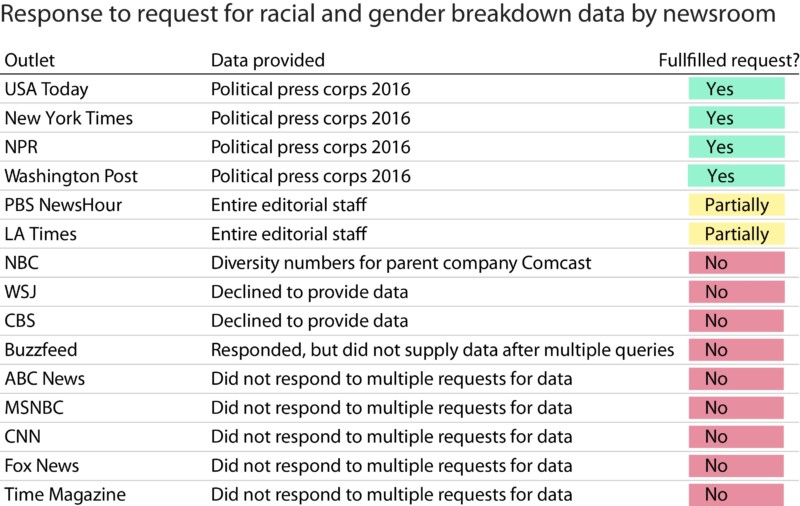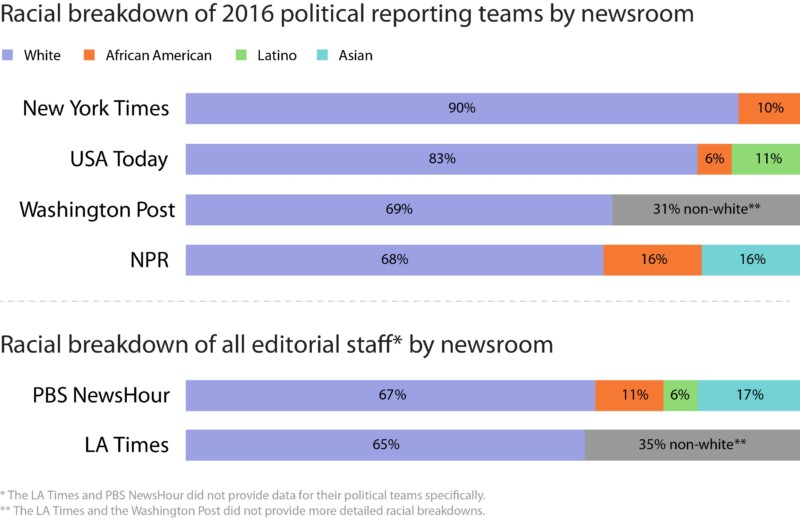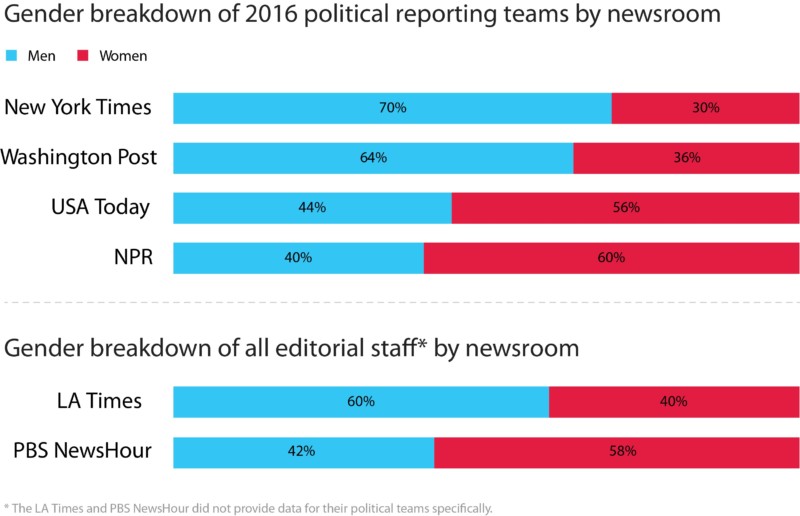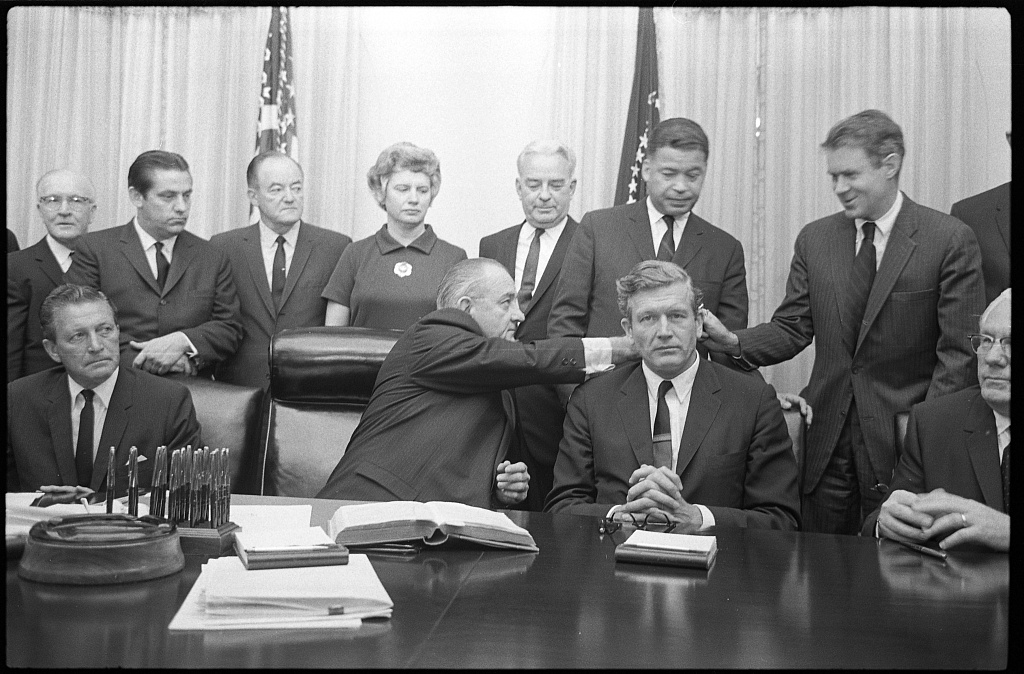Sign up for The Media Today, CJR’s daily newsletter.
The staffing of the American news media has never reflected the diversity of the nation.
For most of the country’s history, Latino and non-white journalists were not welcomed in white-run newsrooms. Instead, they produced content which shed light on issues the white press was ignoring through their own news outlets. In the 1890s, journalist Ida B. Wells covered lynchings that mainstream news outlets overlooked. In the 1950s and 1960s, with only a few black journalists in their newsrooms, newspapers and television networks struggled to cover the Civil Rights movement.
In response, and against the backdrop of cities burning in what were then called “race riots,” President Lyndon B. Johnson convened the National Advisory Commission on Civil Disorders, popularly known as the Kerner Commission. Among the 1968 report’s broader findings, key sections criticized news coverage of race and politics, pointing to the lack of diversity in America’s newsrooms. “Our second and fundamental criticism,” the report states, “is that the news media have failed to analyze and report adequately on racial problems in the United States, and, as a related matter, to meet the Negro’s legitimate expectations in journalism.” Of particular note is the idea that all citizens have a right to “legitimate expectations” that their communities will be covered thoroughly and fairly.
This year, half a century later, while we are commemorating prominent Civil Rights–era events, including the the assassination of Dr. Martin Luther King, Jr., questions persist about newsroom staffing. The American Society of News Editors’ stated goal in 1978 to steadily bring newsroom diversity numbers to parity with national averages has not been met, despite the demographic shift in America’s racial and ethnic makeup. The ASNE’s annual newsroom diversity survey shows that Latino and non-whites made up 12 percent of newspaper editorial staff in 2000, and by 2016 that figure had edged up only slightly, to 17 percent. The US population is currently 38 percent Latino or non-white, more than double the percentage found in newsrooms.
RELATED: One question that turns courageous journalists into cowards
Teri Hayt, ASNE’s executive director, says the numbers “have not moved that much” in recent years. As for why publishers and editors should care about diversity, she says, “You should care because you’re losing audience share [if you don’t].” Melissa Harris-Perry, the Maya Angelou Presidential Chair at Wake Forest University, who is also the founder of the Anna Julia Cooper Center and the former host of the Melissa Harris-Perry show on MSNBC, frames the issue through equity and balance: “The very idea of having to answer the question, ‘Why does it matter for them [i.e., journalists of color] to be there?’ means all the space should be owned by white men. People who live in bodies that are marginalized don’t have to bring anything other than their excellence or mediocrity to the table, because that’s what white people do.”
Meanwhile, we have learned that covering race and politics can be traumatic, with Internet trolls and harassment by interview subjects and hostile news consumers. Jesse Holland, who covers race for the Associated Press, has spoken about the emotional toll of repeatedly covering racially motivated killings. Both Holland and Simon Moya-Smith, an independent Native American journalist, have also addressed the special burden borne by journalists of color. They are sometimes seen as double agents, they note, working both for their ethnic communities and for journalism broadly—sometimes pleasing neither.
Nicki Mayo of the National Association of Black Journalists says she spent the 2008 election in Appalachia, and found herself forcibly dragged into a men’s bathroom while reporting at NASCAR races in Bristol, Tennessee. She was asked to accompany a young white reporter into a black Baltimore neighborhood, but no one had given her an escort when she covered white working-class communities in Appalachia.
The risks of being targeted rose during the 2016 election cycle. The Washington Post’s Robert Samuels, a national political reporter who is black, described being mistaken for a protester at a Trump rally: “As the police pushed me out of that rally, people started calling me ‘monkey,’ a person tried to trip me, they shouted, ‘All lives matter,’ at me,” he said. Candace Smith of ABC wrote about being “the only black reporter who covered Trump in the field (except for the last week of the election),” a beat she was assigned after Jeb Bush dropped out of the race. She and her fellow journalists—especially those perceived to be Jewish, she noted—were targeted by protesters at rallies: “On Twitter, I’ve been called a ‘n—–,’ a ‘c—‘ and, at times, a combination of the two.” Noting “omnipresent” Confederate flags across the country, people on Twitter asked why she was obsessed with race. “But race—as a black woman in America,” she wrote, “is something so many of us are acutely aware of. It is the lens through which everything is filtered.” Though Latino and non-white reporters brought the increasingly hostile racial environment on the campaign trail to the attention of their editors, their warnings were largely ignored.
To cover the 2016 election season, journalists needed a deep knowledge of this nation’s communities and constituents—by race, gender, class, region, and religion, among other factors. Yet most major news outlets and news teams failed to anticipate the unusual nature of the election. And while this does not invalidate their work, post-election assessments have not included systematic analyses of who was chosen to cover the campaign.
I contacted 15 major news outlets for information about their political press corps during the campaign, expecting they would readily provide it. However, despite repeated inquires, fewer than a third—only USA Today, The New York Times, NPR, and The Washington Post—provided the requested data. Others reported partial sets, and still others declined to provide data—or to even respond. (All of the non-respondents were queried through multiple employees and departments over a two-month period.) Many reporters and editors would discuss the issue only on background or off the record, which is curious given the transparency journalists champion when it comes to other institutions.
That said, a few newsrooms quickly responded to my query, and commented in depth. Within half an hour of my request, USA Today responded that its 2016 campaign coverage staff had 10 women and eight men, and, among those, two Latinx reporters and one African-American reporter. The full study is available here, published by the Shorenstein Center.



Lee Horwich, managing editor for government and politics at USA Today, believes 2020 will be challenging for political journalists. “I think that it is vital that we have an understanding of the diversity of staff that we need to approach these problems,” he says. “But not just that, regardless of race/gender/ethnicity of journalists, we need to be reflective of the diversity of the electorate and of the country as a whole, and explain and understand what those people are saying and demanding.” USA Today began assessing its 2020 staffing and editorial needs right after the election. “Four years seems like a long time. It isn’t.”
Both news industry staff diversity and media equity require more study, but particularly, more action. Greater transparency would help those who want to improve diversity to hone their strategies, and possibly to sway newsroom management that was not committed to change. This is particularly true of newsrooms, who could self-report metrics about their staffing patterns and the decisions behind them. That means offering metrics to researchers and general audiences online, in print and in annual reports.
Major news prizes like the Pulitzer and DuPont could require public disclosure of diversity metrics as a qualification for acceptance of the prize.
The industry itself can encourage this. Major news prizes like the Pulitzer and DuPont could require public disclosure of diversity metrics as a qualification for acceptance of the prize. This would broadly affect both the for-profit and the non-profit media outlets that compete for these awards.
Journalists themselves can also create new systems, training, and pipelines. In 2016, award-winning New York Times investigative reporter Nikole Hannah-Jones co-founded the Ida B. Wells Society for Investigative Reporting. Its mission is to increase the hiring and retention of investigative reporters and editors of color, and to educate news organizations about the ways diversity can increase the efficacy and impact of investigative work. In an email, she writes:
Investigative reporting is the most important work that journalists do in a democracy, yet these premier and critical jobs are still almost uniformly filled by white journalists… The more prestigious a job is, the more skills it requires, the less likely people of color are to get the mentoring, training and opportunities to take on those jobs… We intend to provide the type of high-quality mentoring and training that will make it impossible for newsrooms to say they cannot find qualified applicants.
In the first month of the Ida B. Wells Society’s work, more than 600 journalists signed up as members.
Further, journalists might follow the money. Newsroom discrimination settlements requiring non-disclosure agreements are an opportunity for investigative reporters to examine the fiscal and ethical practices of newsrooms. The work of New York Times reporter Emily Steel helped end the Fox News career of Bill O’Reilly, and reshaped Fox News after revealing it had paid tens of millions of dollars in settlements to women in his case and that of network chief Roger Ailes. Still, there has not yet been a major journalistic examination of payments by news outlets to settle cases involving race, ethnicity, age and sexual orientation. An effort by ProPublica to crowdsource NDAs may provide further information.
In retrospect, the Kerner Commission report seems almost hopeful. Although it outlines a grim problem, it presents its issues clearly and with the expectation that the rallying cry will produce action. Today, the lack of urgency to resolve address issues of journalistic diversity and equity means newsrooms must be prodded into action. The words of the Kerner Commission remind us why action is necessary. To reframe their sentiments for our industry and our times:
Our newsrooms are moving towards two different ethical and functional frameworks: one which views the lack of racial and gender equity as inconsequential, and one which realizes the American news industry is not a functional meritocracy. Work remains to be done. This deepening division is not inevitable. The movement apart can be reversed. Choice is still possible. Our principal task as journalists is to define that choice and press for accountability, remedy and resolution in our newsrooms and industry.
Editor’s note: This article is excerpted from a paper, published today, stemming from the author’s work as a Joan Shorenstein Fellow at the Shorenstein Center at Harvard.
RELATED: Five decades after Kerner Report, representation remains an issue in media
Has America ever needed a media defender more than now? Help us by joining CJR today.



